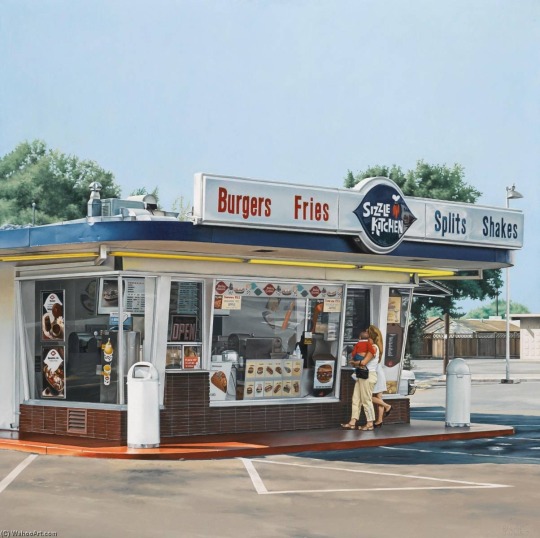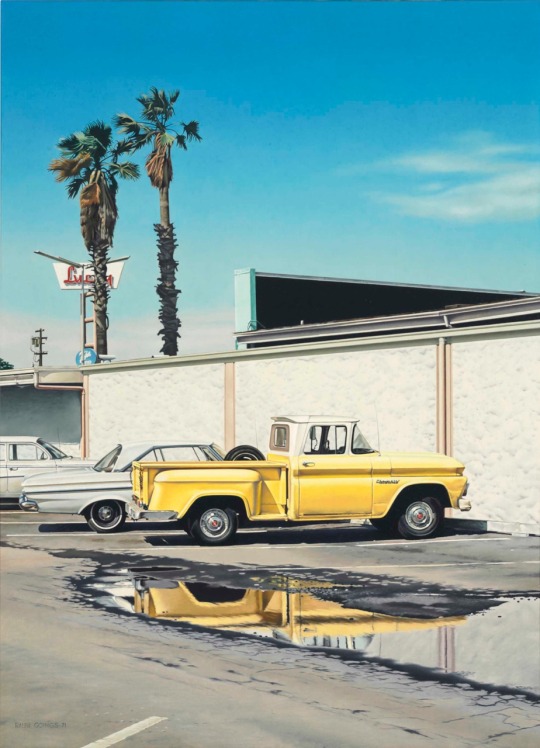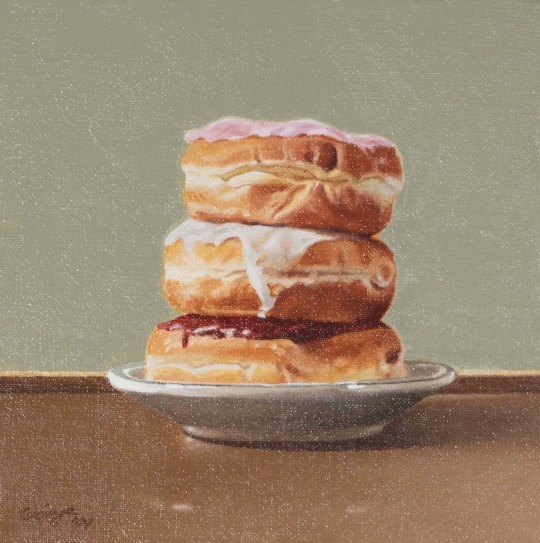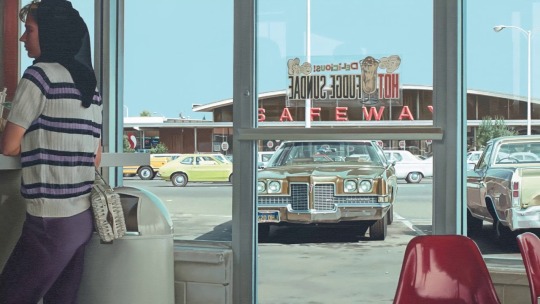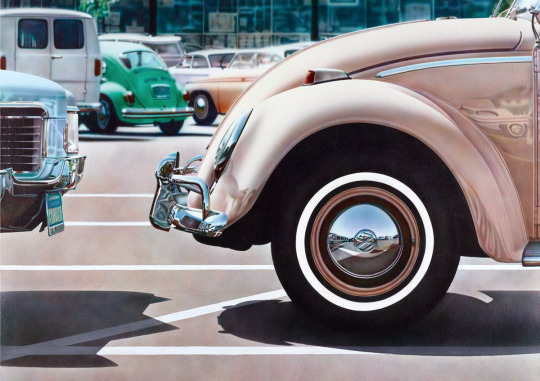Text
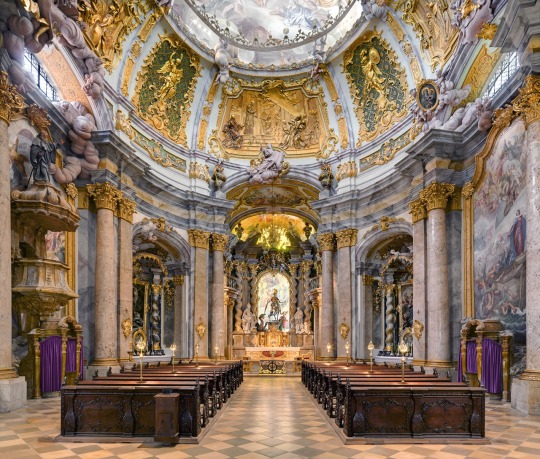

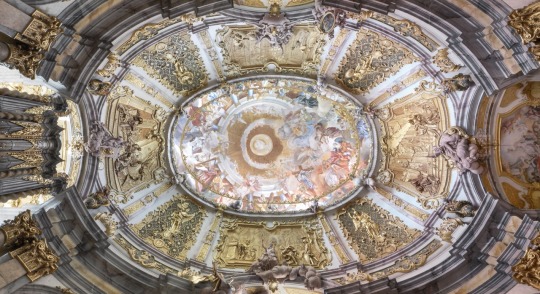
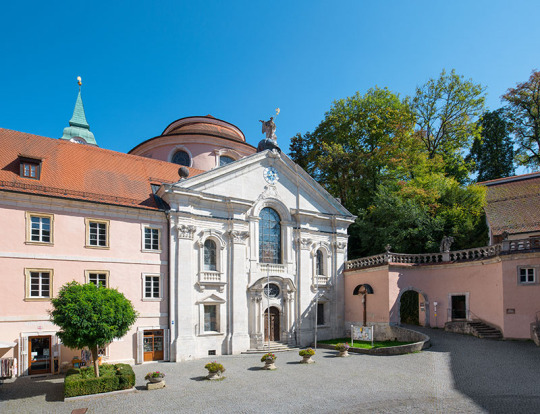
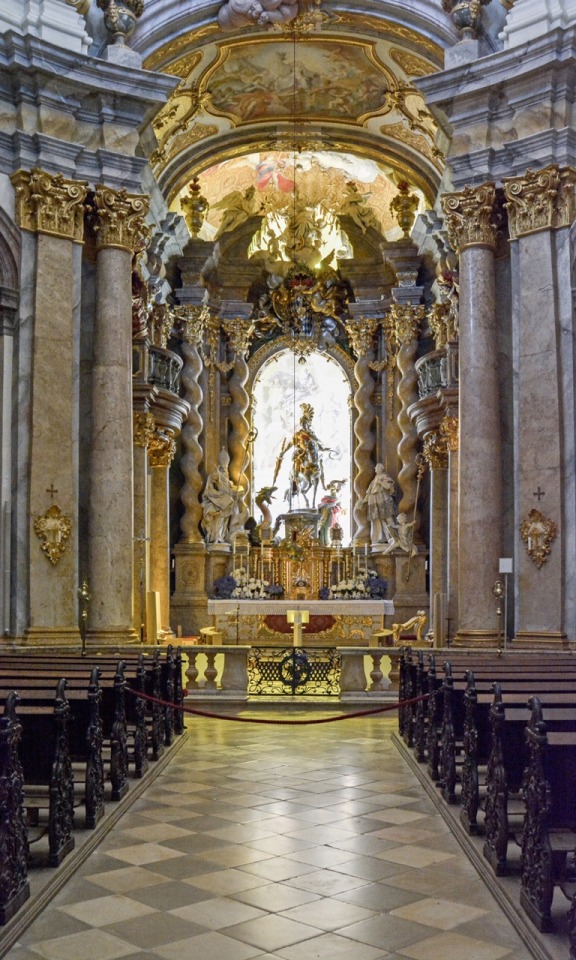


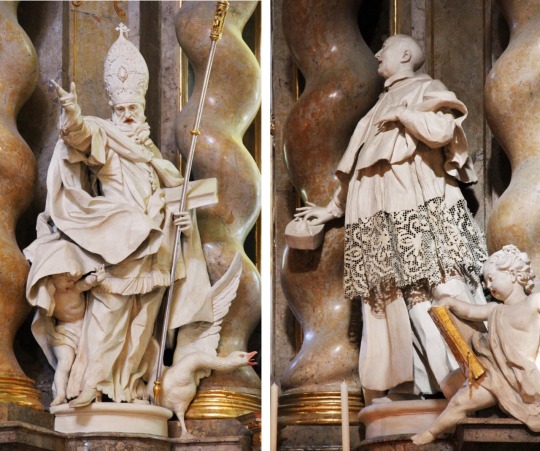
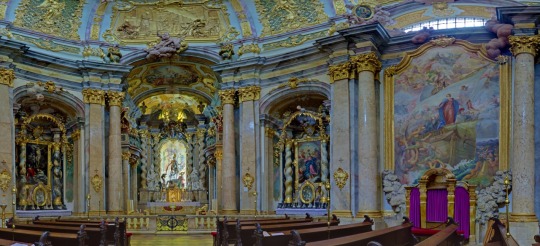
SPÄTBAROCK IN SÜDDEUTSCHLAND UND ÖSTERREICH XII
BENEDIKTINERABTEI ST GEORG ZU WELTENBURG
Founded in AD 617, Kloster Weltenburg is the oldest monastery in Bavaria. Built for strategic reasons on a bend in the Danube, about 25 km east of Regensburg, the abbey buildings are approachable only from the river or from the village of Weltenburg to the south.
During the Thirty Years War, the abbey was repeatedly sacked and plundered. Its buildings were destroyed, the monastic community was greatly reduced and adherence to the Rule abandoned. Abbots were elected only to resign in rapid sucession. This dire state of affairs attracted both papal and imperial attention, which led to the installation of abbot Marius Bächl in 1713. The new abbot's primary duty was the reconstruction of the conventual buildings.
Bächl exceeded expectations. The cloister was rebuilt 1714-16 and the abbey church begun in 1716, based on plans by the obscure Fr. Philipp Plank Planer and carried out by Baumeister Michael Wolf. When the consecration took place in 1718, the church largely finished and roofed. Probably recommended by his patron, the consecrating bishop, Cosmas Damian Asam was commissioned at that time to decorate the interior and design the high altar. Quirid Egil arrived in 1721 and other members of the Asam family of artisans were to follow.
Cosmas Damian and Quirid Egil Asam are often credited as the abbey church, despite the fact that the fabric of the church had been largely rebuilt prior to their arrival at Weltenburg. Aspects of the church's design, however, including the oval nave and illusionistic ceiling fresco, suggest a firsthand knowledge of the Roman baroque, which Cosmas Damian Asam alone among the artists involved possessed after his prolonged stay there. Possible interventions in the Weltenberg plan might have led the Asam Brothers, who had hitherto been identified in the documentary sources as maler and bildhauer, to define themselves after this project as architect-designers.
Be that as it may, the Asams were clearly responsible for the painted, sculpted, and stuccoed decoration of the interior. The most striking feature of the Weltenburg interior is the multi-media high altar, which occupies most of the choir. In the Roman baroque tradition, this ensemble blends sculpture, architecture, stucco, and painting into a spectacular theatrum sacrum. Beneath a triumphal arch supported by twisted marble columns stands a sculptural group by Egid representing the abbey's patron, St George slaying the dragon while rescuing the princess. Rather than occupying the same space as the dragon and princess, however, the equestrian figure stands on a base, recalling the statue of Marcus Aurelius on the Campidoglio. Like that ancient monument, The horse and figure appear to be fashioned of metal; in reality, the work is a wood and stucco confection, brilliantly polychromed by the Fassmalerin, Maria Salome Asam, sister of the Asam brothers. Like the inclusion of the base, polychrome is intended to create the illusion not of a saint riding a horse but of an expensive representation of a saint riding a horse. This group is flanked by the helper saints Martin of Tours and Marius of Subiaco (a stand-in for abbot Marius). A wall fresco by Cosmas Damian depicting the Assumption of the Virgin serves as a backdrop for the sculpture.
The Asams appear to have left Weltenburg around 1724 after the completion of the high altar. For the next decade, construction focused on the monastic support buildings and the church façade. Abbot Marius recalled the Asam brothers to Weltenburg in 1734 to fresco the nave walls and to add the four diagonal niches, which were designed by Egid. The ceiling fresco is by Franz Erasmus Asam, the son of Cosmas Damian.
Having fulfilled his mission, Marius Bächl, now hailed as the "second founder" of the abbey, resigned his abbacy in 1743 at the age of 75.
For an excellent overview of the building history of Weltenburg, see the article by Pius Bieri here.
Previous installments in the German Late Baroque series:
I. ASAMKIRCHE, MÜNCHEN
II. THE PILGRIMAGE CHURCH AT WIES
III. KLOSTER NERESHEIM
IV. THE TREPPENHAUS OF THE WÜRZBURGER RESIDENZ
V. DAS MARKGRÄFLICHES OPERNHAUS ZU BAYREUTH
VI. STIFTSBIBLIOTHEK ADMONT
VII. VIERZEHNHEILIGEN
VIII. DAS HELBLINGHAUS
IX. GERMAN BAROQUE ORGAN LOFTS
X. KLOSTER OTTOBEUREN
XI. DIESSEN AM AMMERSEE
XII. BENEDKTINERABTEI ST GEORG ZU WELTENBURG
59 notes
·
View notes
Text

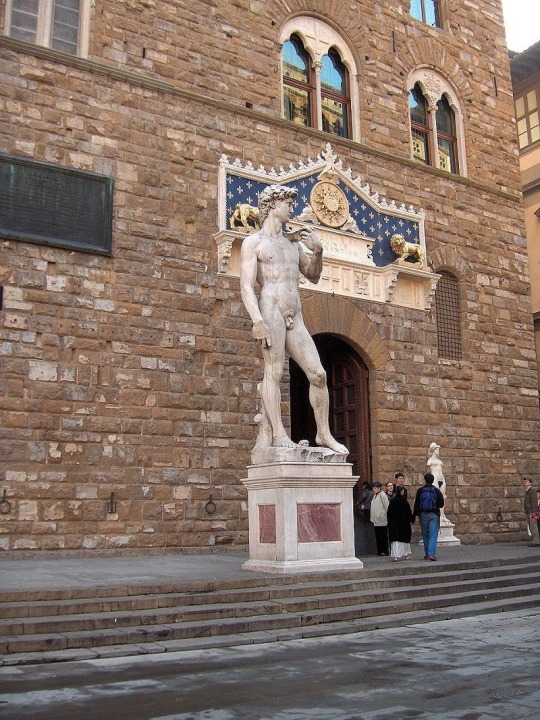



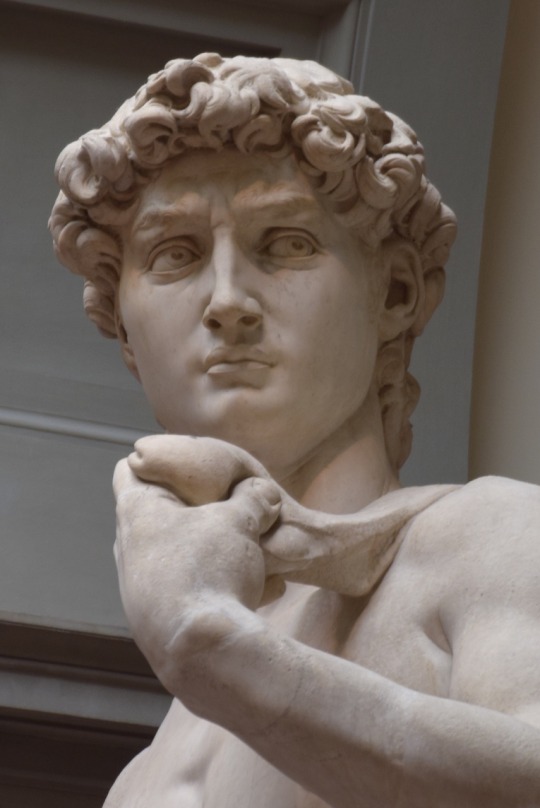
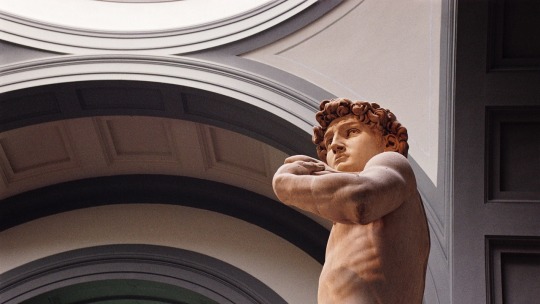
FLORENTINE CIVIC SCULPTURE III: DAVID AS REPUBLICAN GUARD
The marble David carved by Michelangelo for the Operai of the Florentine duomo between 1501-1504 is surely the most famous sculpture ever produced and, with the possible exception of Leonardo and the Mona Lisa, the work of art that most completely symbolizes for the public its creator's genius.
The statue, however, has an oddly tenuous relationship to the artist. The operai ordered the elongated block from the Cararra quarries in the early 1460s to be used for a standing figure of David, which was destined for the upper reaches of the cathedral's exterior. Two sculptors had worked on the David block, before it was abandoned outdoors for 25 years. The location had been decided before Michelangelo was born and changed without warning after he had finished it. To put it another way, the artist did not formulate the subject matter, did not choose the pose of the figure, or control the circumstances of the display of the work most closely associated with him. And yet it seems impossible not to see the David as the product of his particular artistry.
1464: Agostino di Duccio commissioned to carve free-standing David to be placed on an exterior buttress of Duomo. He begins work on block of Carrara marble, roughing out placement of feet and legs, arrangements that effectively determined the figure's pose and stance.
1466: Death of Donatello; Agostino ceases work on David.
1476: Antonio Rossellino briefly works on David.
1476-1501: Unfinished block lies exposed to elements
1501: Operai begin search for sculptor to finish David, despite poor condition of block. Twenty-six year old Michelangelo asks for, and is awarded, commission.
1504: As statue nears completion in January, Operai realize impossibility of lifting and installing it on intended location on cathedral. Committee of 30 prominent architects and artists, including Leonardo da Vinci, Botticelli, Piero di Cosimo, Attavante de' Attavanti and Giuliano da Sangallo, convened to consider a new location for David. Most favored places are Loggia dei Lanzi, entrance to the Palazzo della Signoria and inner courtyard of the Palazzo della Signoria.
1504: In June, Donatello's bronze Judith moved from the entrance to the Palazzo della Signoria to the inner courtyard. Over a period of four days, 40 men move the 5.2 m statue of David from Michelangelo's studio, which was located behind the duomo, to the entrance of the Palazzo della Signoria, where it is installed on its pedestal. The civic context transforms the biblical figure into a political symbol of the Florentine regime. With his pose of armed readiness and wary gaze, David symbolized the vigilance and determination of the recently-refounded Republic, while guarding its principal site of government.
Despite its overt use as a political symbol by the republican government, the David remained in situ after the return of the Medici to Florence in 1497 and after the creation of the ducato in 1530. It was moved indoors to the Galleria dell' Accademia in the 19th century due to weathering concerns.
29 notes
·
View notes
Text

David Chester French in his New York studio in 1889. working on the preliminary, full-sized clay version of Thomas Hopkins Gallaudet and Alice Cogswell monument. man seated on the steps and the girl at the right are alternately serving as the models for the figures of Gallaudet and Cogswell. The final bronze group made from the cast of this model is on the grounds of Gallaudet College in Washington DC.
The photograph is in the Department of Image Collections of the National Gallery of Art in Washington DC.
34 notes
·
View notes
Text
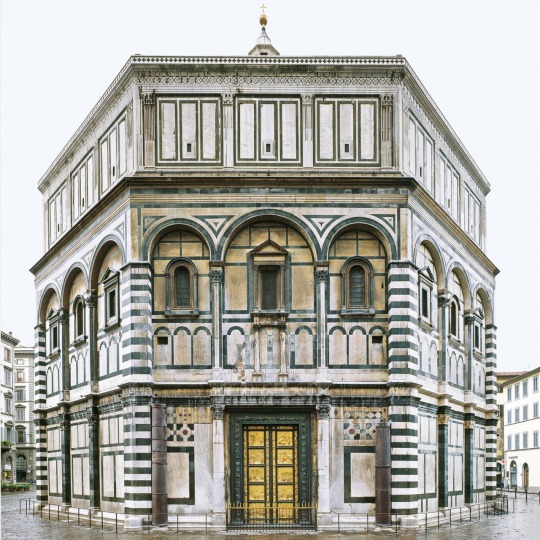
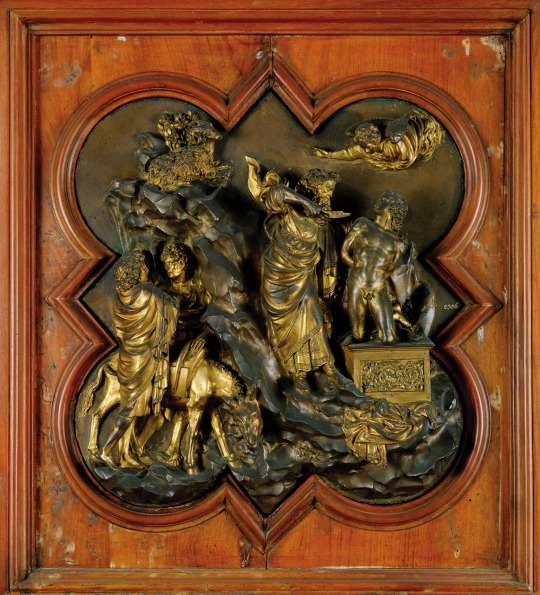

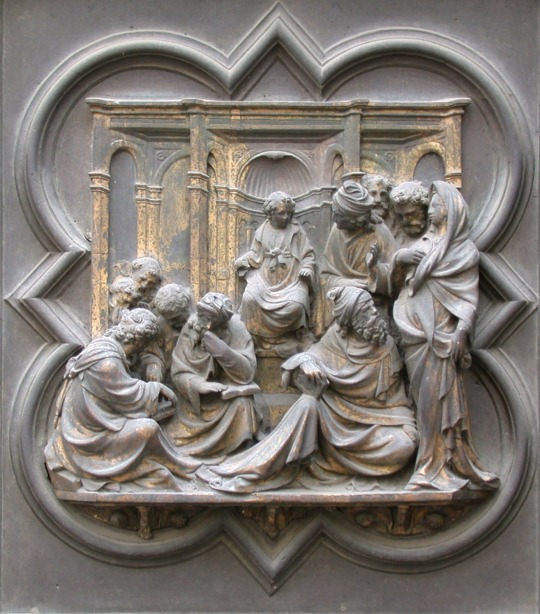
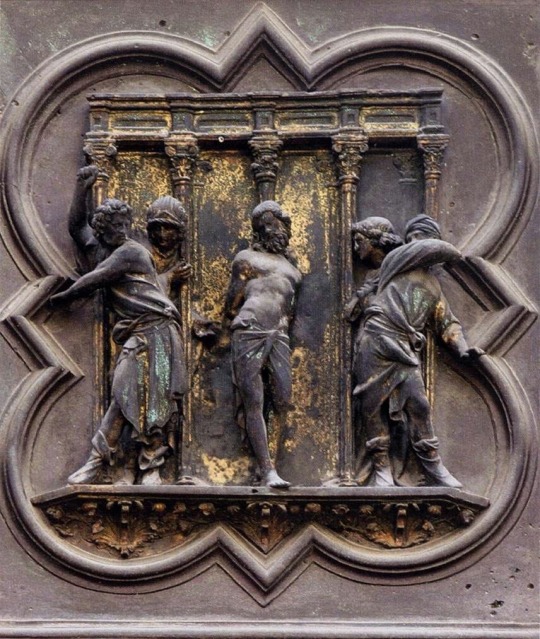
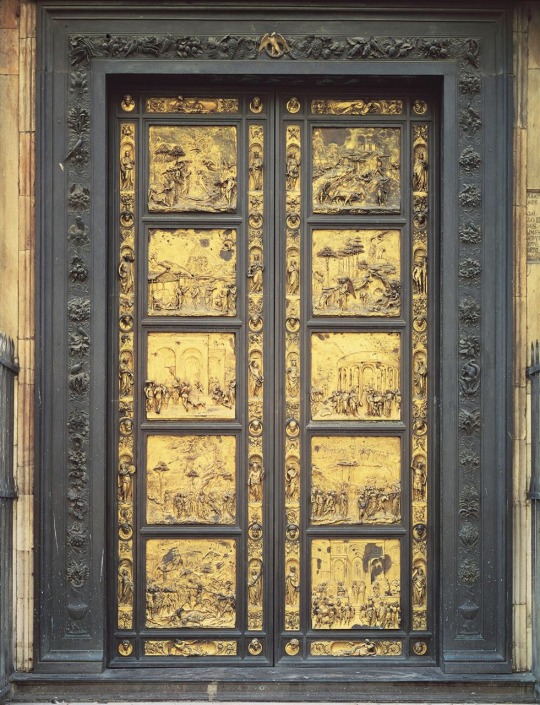

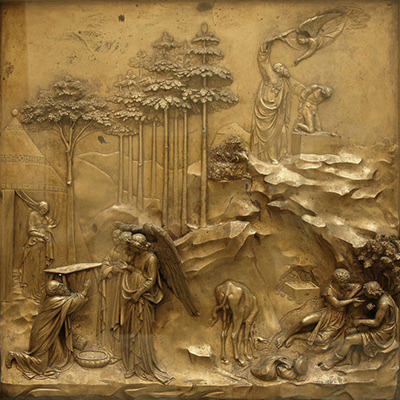

FLORENTINE CIVIC SCULPTURE II: GHIBERTI'S BAPTISTRY BRONZE DOORS
Although the Florentine duomo and baptistry form the religious center of the city, the two buildings were sustained by the civic patronage of the two richest guilds, the Arte di Calimala and the Arte della Lana. The Arte di Calimala assertively competed with their rival guild by focusing their patronage on the east portal of the baptistry, which directly faces the duomo. No less than three sets of monumental bronze doors were commissioned and installed in that location between 1336 and 1452 (in contrast to the duomo, which lacked a façade until the 19th century). Both the Calimala and Lana guilds commissioned Ghiberti to create the bronze statues of their patron saints for Orsanmichele.
The 10 reliefs of the final set of baptistry doors, designed by Lorenzo Ghiberti and later referred to as the "gates of paradise" by Michelangelo, are hybrid masterpieces of pictorial and sculptural representation.
1329: Andrea Pisano is awarded commission for east bronze doors depicting New Twstament scenes for Baptistry of San Giovanni.
1336: Pisano doors completed and installed in east portal.
1401: Based on relief depicting the Sacrifice of Isaac, Lorenzo Ghiberti, a member of father Bartolo di Michele's workshop, is chosen over Filippo Brunelleschi in competition for new set of east bronze doors for baptistry.
1403: Commission for 28 panels for new east door, depicting New Testament scenes, officially awarded to Bartolo di Michele's workshop.
1407: Commission transferred legally to Ghiberti's workshop.
1424: New east doors for baptistry completed.
1425: New east doors by Ghiberti worshop installed in east portal; Pisano doors relocated to south portal; Ghiberti awarded commission for another set of "new" east bronze doors, depicting 10 Old Testament scenes.
1437: 10 panels depicting Old Testament scenes cast.
1452: New east doors consisting of 10 Old Testment relief panels completed by Ghiberti workshop and installed in the east portal.
1453: Ghiberti and son Vittorino receive commission for new door case with relief frames for Pisano doors.
1455: Death of Lorenzo Ghiberti.
1463: New case for Pisano doors, including inscription recording Pisano as sculptor and original date of completion, finished by Vittorino and installed.
56 notes
·
View notes
Text





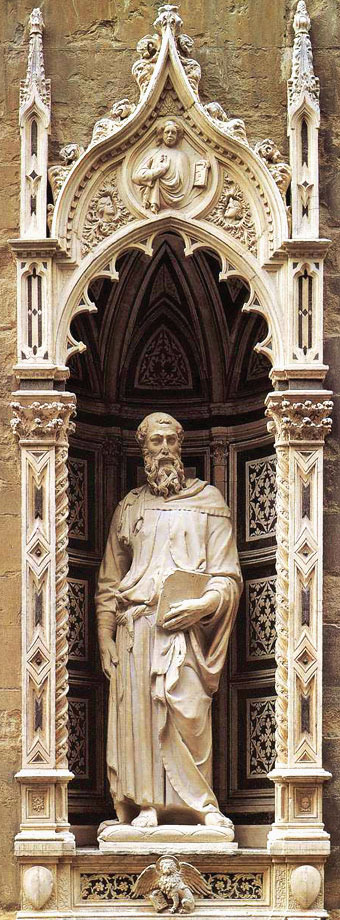


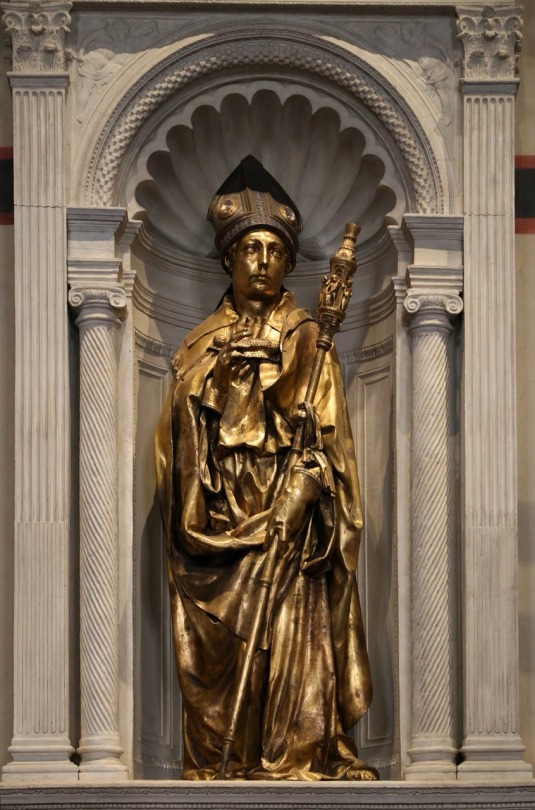
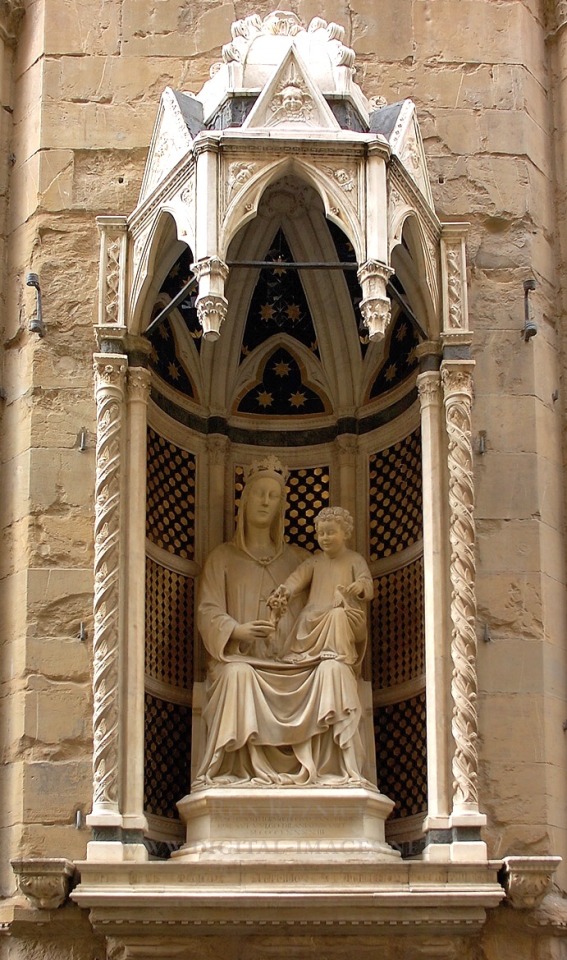
FLORENTINE CIVIC SCULPTURE I: THE EXTERIOR SCULPTURES OF ORSANMICHELE
For the first quarter of the 15th century, the guild church of Orsanmichele was a constantly evolving display space for Florentine sculpture, with innovative figures by major sculptors appearing on the exterior every 1-3 years. Some of the most important developments in Renaissance sculpture occurred at Orsanmichele, including the use of linear perspective in relief sculpture and the recovery of the ancient techniques of monumental bronze casting.
1337: Loggia constructed in the Florentine grain market at Orsanmichele.
1348: Orsanmichele converted to a chapel for major guilds of Florence. Upper level converted to municipal granary.
1359: Loggia enclosed.
1380-1404: City's 14 major guilds required to supply full-sized, free-standing bronze or marble statue of its patron saint for placement in a niche on the exterior of the ground floor. Cost of bronze figure approximately 10 times more than marble figure.
1399: Giovanni di Piero Tedesco, Madonna of the Rose (marble), Arte del Medici e Speziali, installed.
1406: With only 3 of 14 statues installed, city ordinance requires all guild statues installed by 1416.
1408: Nanni di Banco, Quattro Santi Coronati (marble), Maestri di Pietra e Legname, installed.
1411: Donatello, St Mark (marble), Arte dei Linaiuoli e Rigattieri, installed.
1411-1415: Nanni di Banco, St Eligius (marble), Arte dei Maniscalchi, installed.
1412-1414: Nanni di Banco, St Philip (marble), Arte dei Calzaiuoli, installed.
1412-1416: Lorenzo Ghiberti, St John the Baptist (bronze), Arte di Calimana, installed.
1412-1415: Niccolò di Piero Lamberti, St James the Major (marble), Arte dei Conciatori e Pellicciai, installed.
1415: Filippo Brunelleschi, St Peter (marble), Arte dei Becchai, installed.
1416: Donatello, St George (marble), Arte dei Corazzai, installed.
1419-1420: Lorenzo Ghiberti, St Matthew (bronze), Arte del Cambio, installed.
1423-1425: Donatello, St Louis of Toulouse (bronze), Parte Guelfa, installed. Later replaced by Verrochio group.
1428: Lorenzo Ghiberti, St Stephen (bronze), Arte della Lana, installed.
1467-1483: Andrea del Verrocchio, Christ and St Thomas (bronze), Tribunale di Mercanzia, installed.
#italian renaissance sculpture#orsanmichele#grain market#florence#donatello#guilds#ghiberti#bronze sculpture
14 notes
·
View notes
Text
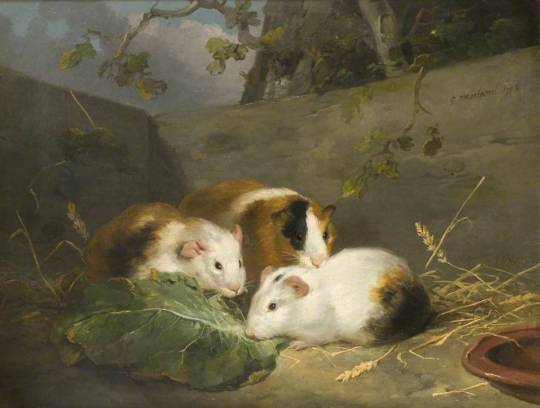
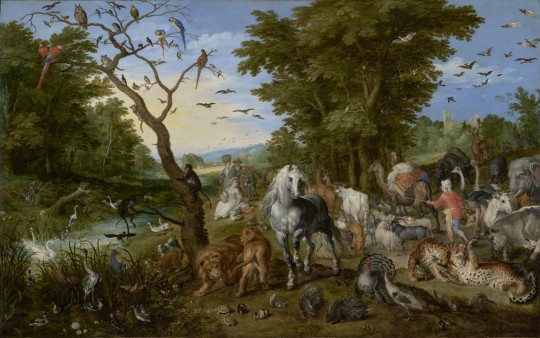

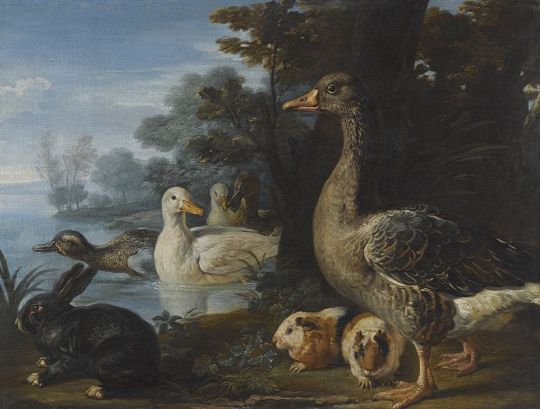



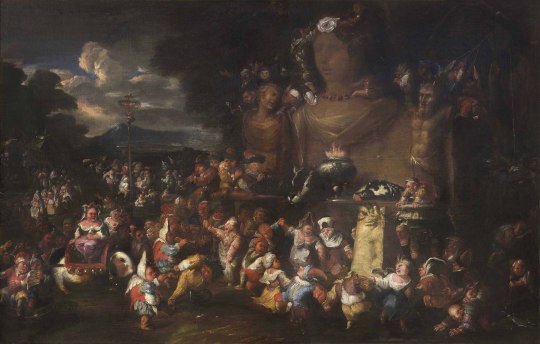
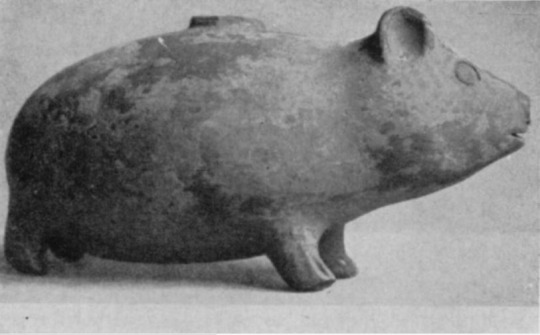

THE GUINEA PIG IN ART
The guinea pig does not exist in the wild. Caviae tschudii were domesticated by the pre-Incan Andeans. They were used as housepets, as honorific gifts, and in religious healing rituals through Meso-America for centuries. They were also commonly represented in stone and ceramic sculpture. Despite the name, guineas pigs are not found in Guinea, nor are they related to pigs. The French name cochin d'Inde reflects the use of the generic term "Indies" to refer to the New World.
Guinea pigs were imported, along with gold and other commodities, into Europe in the mid-16th century, where they were kept as exotic pets by the wealthy. The first guinea pig depicted in western art appears in a portrait by an unknown Flemish artist of three English children, dated 1580.
In the 17th century, guineas pigs are often among the animals inhabiting paradise in paintings nominally depicting the Fall of Man or in images of the animals on Noah's ark. Such taxonomic pictures were often displayed in the curiosity cabinets of patrons with natural science interests. Guinea pigs could also be disguised symbols in mythological pictures, as seen above in the work by Rubens, where a pair eat fig leaves at the feet of Venus and Mars. Eccentric artists like Faustino Bocchi put them to ridiculous Boschian uses.
In the later 18th century, they are are one a several cute animals favored by painters of sentimental genre scenes.
George Morland, Guinea Pigs, 1792; Jan Brueghel the Elder, Animals Entering Noah's Ark, 1613; Jan Brueghel the Elder and Peter Paul Rubens, Venus Disarming Mars, 1612; David de Coninck, Ducks, Guinea Pigs and a Rabbit in a Wooded Landscape, after 1701; George Stevens, The Favourite, c. 1810; Jan Brueghel the Elder and Peter Paul Rubens, Adam and Eve in Paradise, 1615; Jakob Bogdani, Capuchin squirrel monkey, two guinea pigs, a blue tit and an Amazon St. Vincent parrot with Peaches, Figs and Pears, c. 1700; Faustino Bocchi, Allegory of Marriage, c. 1700; Andean Ceramic Guinea Pig, c. AD 700; Unknown Netherlandish, Three Children with Guinea Pig, c. 1580.
31 notes
·
View notes
Text


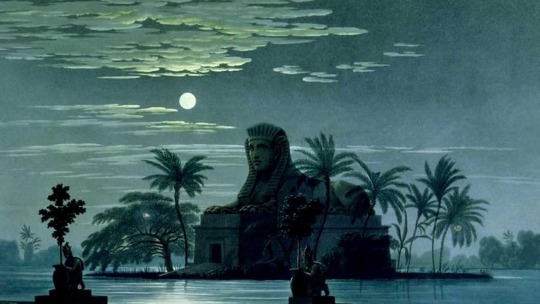
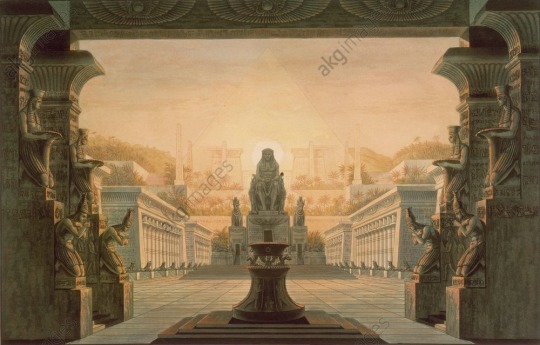




SCHINKEL'S EGYPTIAN ZAUBERFLÖTE
Architect Karl Friedrich Schinkel published the portfolio of his designs for theatrical sets, Sammlung von Theater-Dekorationen, in 1819 (reprinted many times in the 19th century). This deluxe collection of large, aquatint plates representing Schinkel's stage designs for numerous operas featured eight fantastical backdrops for a production of Mozart's equally-fantastic opera Die Zauberflöte (1791), staged in Berlin in 1815.
Die Zauberflöte's libretto , composed by the actor-impresario Emmanuel Schikaneder, a pastiche of fairy tales, magical lore and vaguely-defined exotic locations, further muddled by superficial references to Freemasonry, Rosicrucianism, and other forms of esotericism. Schikaneder's references to a Temple of the Sun and the aria " O Isis und Osiris") prompted Schinkel to give the opera a full-blown ancient Egyptian treatment, complete with sphinxes, palm trees, colossal statuary and hypostyle temples.
These fanciful sets not only reflect the Egyptomania that dominated the period, but they announce as well the Schinkel's stylistic transition from Neo-classicism to the Romantic historicism and eclecticism of his later work.
588 notes
·
View notes
Text
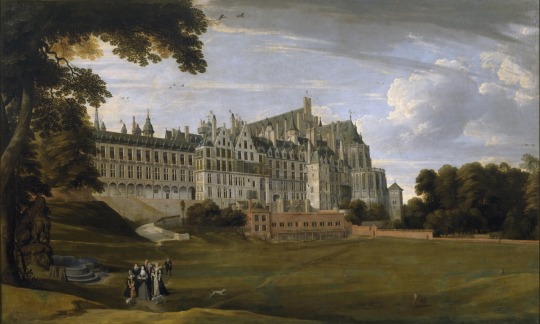
Jan Brueghel the Younger, The Royal Palace in Brussels (The Palace of Coudenberg), 1627, Madrid, Museo del Prado.
Built on the Coundenberg Hill in central Brussels, the Palace of Coudenberg was the seat of government of the Burgundian and Hapsburg rulers of the Low Countries. Raised and educated in Brussels, Emperor Charles V considered the palace his principle residence. In the 17th century, the palace was extensively remodeled and expanded, taking the form seen in this view by court artist, Jan Brueghel the Younger.
The palace was largely destroyed by a fire in 1731 and never rebuilt.
18 notes
·
View notes
Text
tumblr tuesday: museum friends
It’s International Museum Day, happy International Museum Day! In honor of International Museum Day, here are some digital images of inanimate objects depicting animate objects: animal friends from discerning curators, collectors, and museums. Are you ready to marvel, to goggle, to ooooh and aaaah? Lovely. Welcome to the museum.

This little monkey is smiling (kinda) because it has just seen its first IRL humans in a long while at the Ashmolean Museum (@ashmoleanmuseum).

Gamboling kittens at The Children’s Museum of Indianapolis (@thechildrensmuseum).
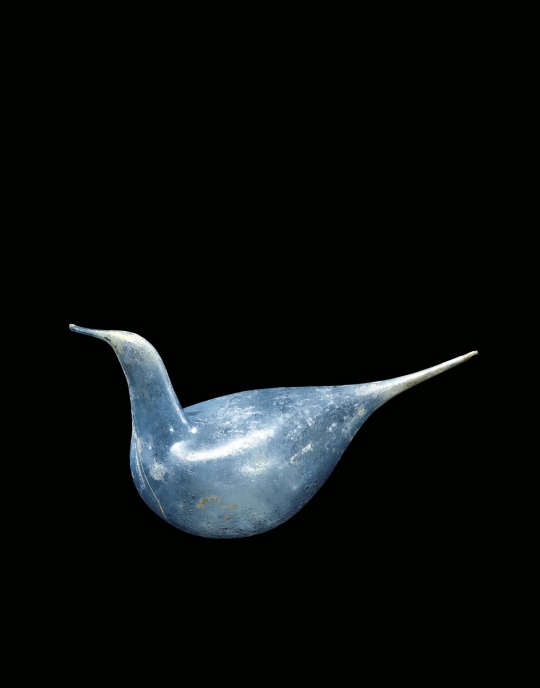
A smoothly blue-blown glass bird vessel that lives at the Corning Museum of Glass (@cmog).
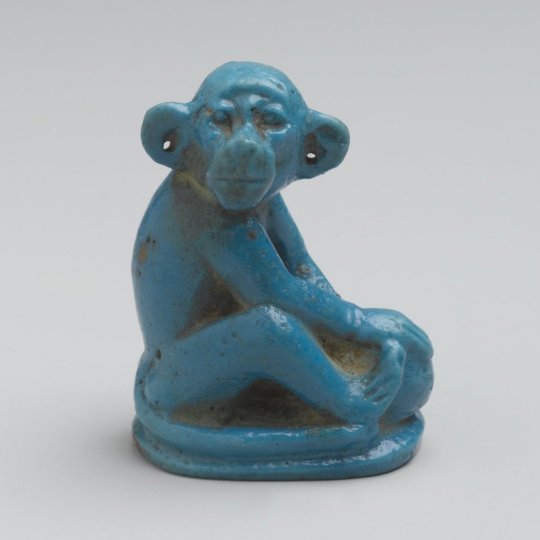
This blue monkey is apparently very old. And now it is in Brooklyn, courtesy of Booklyn Museum (@brooklynmuseum).

An ox, now resident in the Philadelphia Museum of Art (@philamuseum).

Found among art history buff @artfoli‘s finds: the earliest-known 3D likeness of a cat in Egyptian art. It’s no Etruscan boar, but woah. We’ll take it.
15K notes
·
View notes
Text
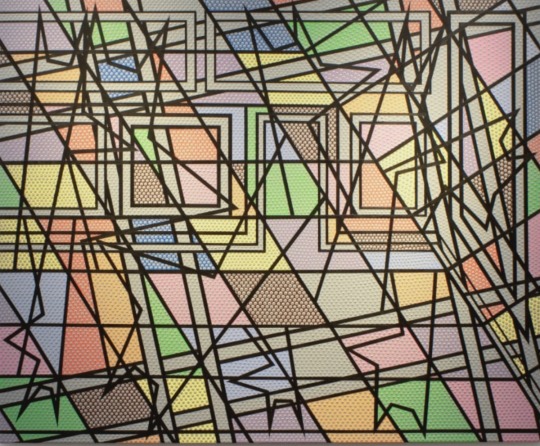

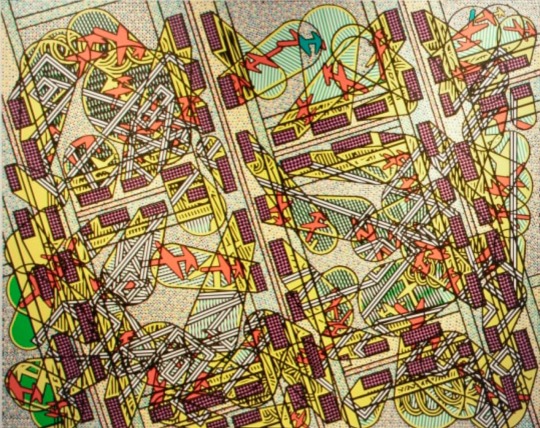


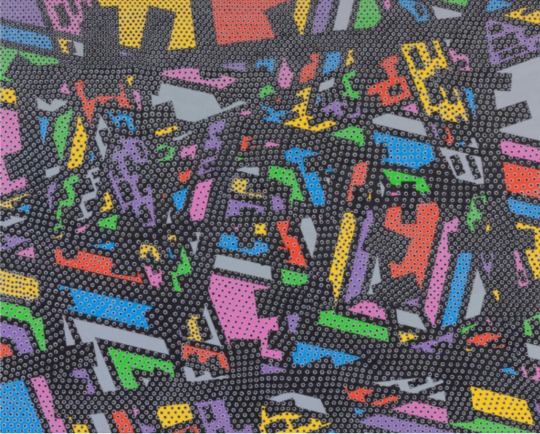
BERNARD COHEN (British, b. 1933)
"There is nothing that appears in my paintings that hasn’t been seen by me or experienced by me. I paint things that I’ve seen, things that are part of the everyday, the ordinary. Among things that I see are random things: the way things overlap or interfere with each other. The random has become a very important part of my painting."
7 notes
·
View notes
Text

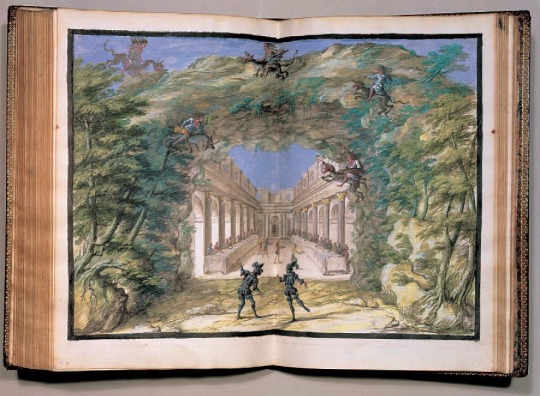
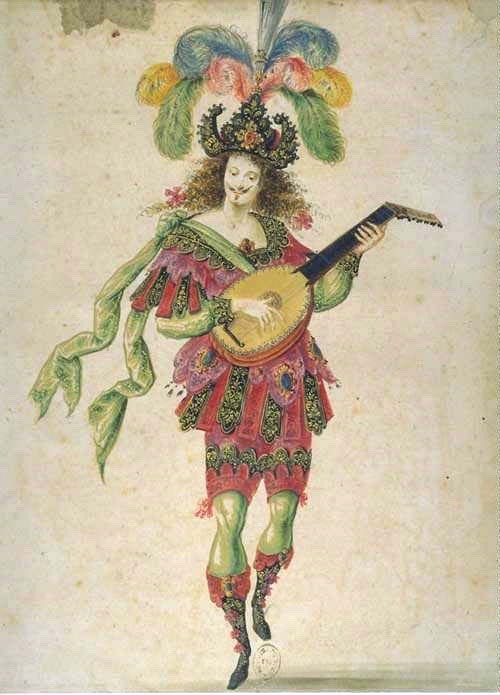

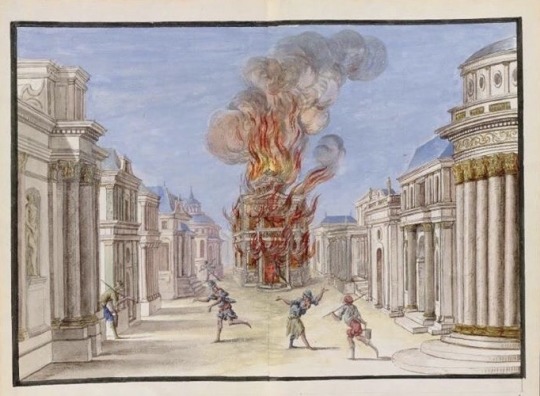

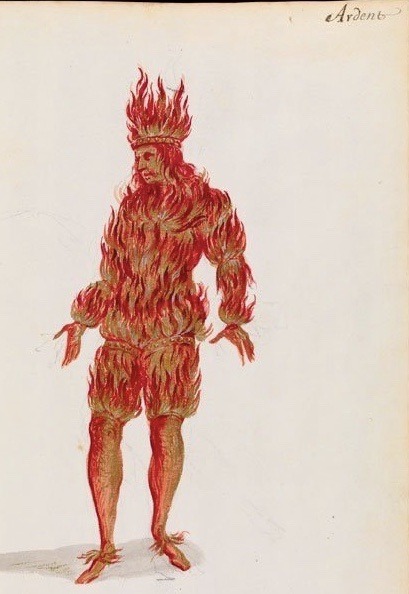
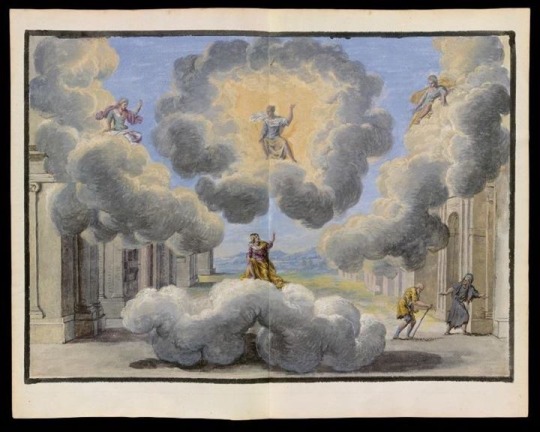


LE BALLET ROYAL DE LA NUIT
To mark the defeat of the Fronde, on 23 February 1653, a masque-like spectacle of dance and music was staged in the Salle du Petit-Bourbon in the Louvre in honor of the Queen regent, Anne d'Autriche, and her first minister, Cardinal Mazarin. Entitled the Ballet Royal de la Nuit, the piece was an epic, all-night production, commencing at 6:00 PM and concluding 13 hours later at 6:00 AM. Divided into four "watches," the performance comprised 45 entrées réparties, 3 ballets-within-the-ballet, numerous airs, and theatrical sketches. The 15-yr old Louis XIV, an accomplished dancer, appeared as several characters, including Le Sol Levant. When a paper backdrop caught fire during his performance, the young king kept calm to avert an audience panic, thus allowing the ballet to continue to its end. The ballet was performed 7 times over two weeks, and was revived several times in the later 17th and 18th centuries.
The subject and overall form of the ballet was conceived by Le Sieur Clément, intendant of the duc de Nemours. The concept called for the representation of gods and goddesses, allegorical figures, "low" scenes of gypsies, thieves, and peasants, and such "horreurs" as witches, werewolves and demons performing a Black Mass. The court poet Isaac de Bensérade wrote the texts, which were set to music by Jean de Cambefort, Jean-Baptiste Boësset, Michel Lambert and Louis de Mollier. The choreography, which is preserved in an early form of dance notation, is attributed to Mollier. The set designs by Italian scenographer Giacomo Torelli were engraved by Cochin and published in a lavish livre de fête. Drawings by Henri de Gissy made for a 1662 reprise of the ballet, record the original costumes designs.
Despite its arduous length and highly-artificial content, the Ballet Royal de la Nuit continues to be staged by modern dance companies.
158 notes
·
View notes
Text


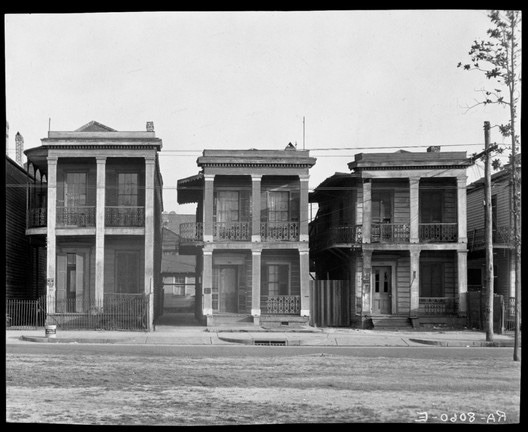






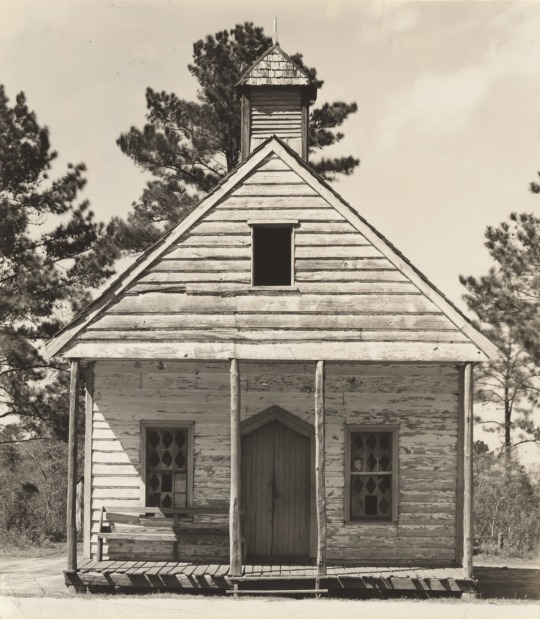
WALKER EVANS
Svetlana Alpers, Walker Evans: Starting from Scratch (Princeton University Press, 2020)
Walker Evans, American Photographs (Museum of Modern Art, 1938, 1961, 1975, 2012 editions).
#walker evans#photography#hasselblad#lincoln kirstein#svetlana alpers#great depression#new deal#eugène atget
34 notes
·
View notes
Text




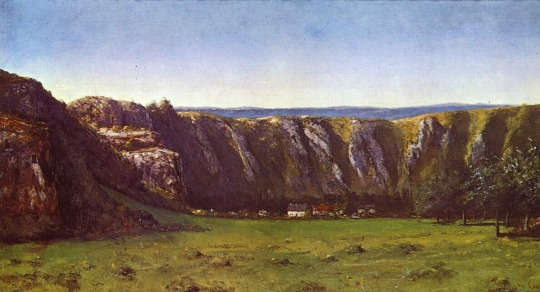


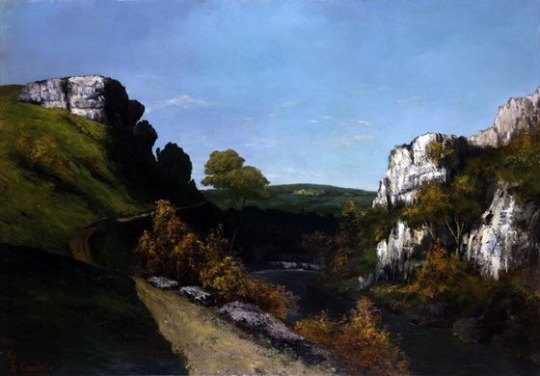
COURBET AND THE MODERN LANDSCAPE
Courbet's outsized representation of The Artist's Studio (1855), subtitled "allégorie réelle déterminant une phase de sept années de ma vie artistique et morale," served as a mid-career reckoning, a theoretical manifesto and a program for future action. At the center of the work, the artist is seen in the act of painting. Although a conspicuously undraped female model stands beside him, she is not represented in the picture, nor are any of the other characters present in the studio. The painting in progress is, in fact, not figural. For this polemical and confessional grande machine, Courbet define himself not as the painter of somber provincials and rough, vigorous peasants, but as painter of landscapes. Over the next 15 years, landscape painting would account for three quarters of Courbet's artistic production. Lacking the controversy of his figural works, the landscapes were a great success with collectors, making him a considerable fortune.

His landscapes depict the region of the Franche-Comté around Ornans, his place of birth. Associated with deep geological time, Courbet's rugged, inhospitable landscapes are beyond aesthetic categories like the sublime and the picturesque. Primordial, enduring, and indifferent, they are the antithesis of the evanescent, refinements of civilization, epitomized by the glittering metropolis. The natives of such a land reflect their environment. Therefore, the array of somber, roughhewn inhabitants of Ornans depicted in the act of Enterrement, resembles the distinctive local cliff formations that Courbet would subsequently paint. His own desire to be to be understood as the artistic manifestation of this radically-primal and vital topography is emphasized by the representation of his own body in The Artist's Studio, which seems literally to merge and emerge from the landscape he paints.
Courbet's transition from figural to landscape painting might appear to be a calculated retreat from his early, politicized Realist works to a more collector-friendly, saleable landscapes. The latter, however, continue to engage with the avant-garde obliquely, through their heavy, gritty facture. Laid on like cement with a trowel in places, the heavily-built up surfaces that foreground the materiality of the painted medium are diametrically opposed to the self-effacing finish and sheen of salon painting. That this style was clearly perceived to be "modern" is seen in its appeal to the Impressionist avant-garde: Monet's Rouen Cathedral series, the winter landscapes of Monet, Sisley, and Pissarro and numerous views of L' Étretat, are all highly-indebted to Courbet's landscapes.
19 notes
·
View notes
Text


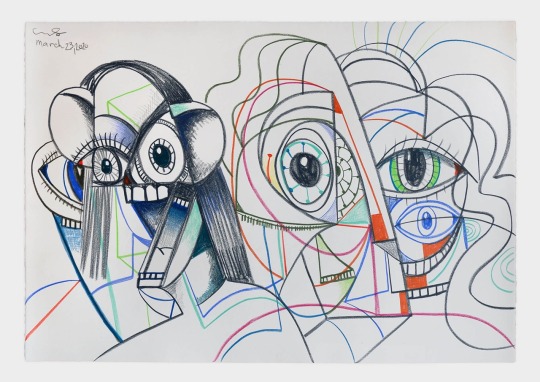

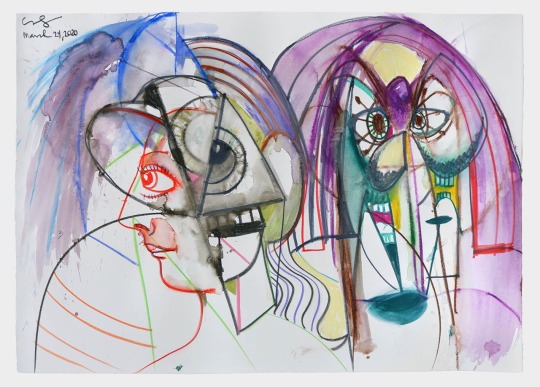

GEORGE CONDO, Drawings for Distanced Figures, 2020
Made during the last three weeks [March, 2020], in the artist’s home studio in New York state, these portrait drawings are evocative of the experience of isolation during this unsettling period of social distance. Depicted in crayon, pencil and ink, overlapping figures are layered, combining multiple viewpoints to reflect different emotions occurring simultaneously; fear, paranoia, claustrophobia, panic and distress are portrayed in this particular group of drawings but handled with such beauty, elegance and resolve as to provide an antidote.
As in previous works, Condo’s ‘Distanced Figures’ synthesize pictorial languages and motifs to create what he describes as ‘composites of various psychological states’. The themes in the drawings not only respond to our current situation and the absence of human contact, they are a continuation of the recurrent themes in the artist’s work. The figures in this new series of works often appear in pairs, linked by intersecting lines, yet their viewpoints do not connect. For Condo, the condition of isolation also carries positive connotations of seclusion in the studio space.
from Hauser-Wirth's press release
49 notes
·
View notes
Text

Andrea Ciccione (da Firenze), Tomb of King Ladislao of Durazzo, after 1414, Napoli, San Giovanni a Carbonara.
Ladislao of Durazzo (1377-1414) was the last Angevin king of Naples. Carrying out his plan for the creation of a royal pantheon in San Giovanni a Carbonara, dedicated to the late Angevin rulers of Naples, his daughter and successor, Joanna II of Durazzo, ordered his tomb to be placed the apse of the church.
Designed by the Florentine sculptor Andrea Ciccione, the multi-tiered monument far surpasses the earlier Angevin tombs elsewhere in Naples in scale and sumptuousness. Framed by a hybrid of Gothic and Renaissance architectural elements, the sculptural program includes allegorical figures of Virtues, images of Ladislao and Joanna enthroned, the funerary effigy of Ladislao, and, at the apex, an equestrian portrait of the King arrayed in full chivalric armor.
45 notes
·
View notes
Text


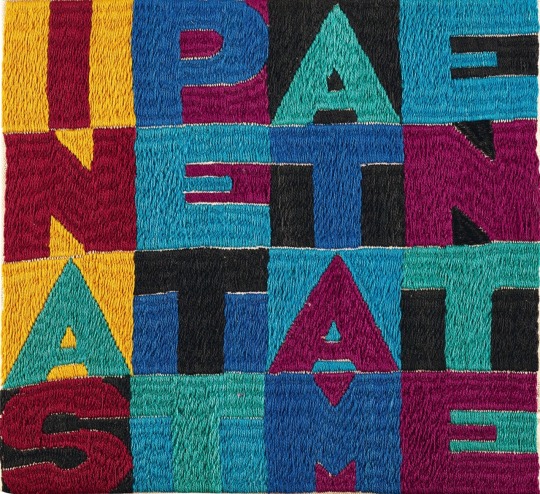
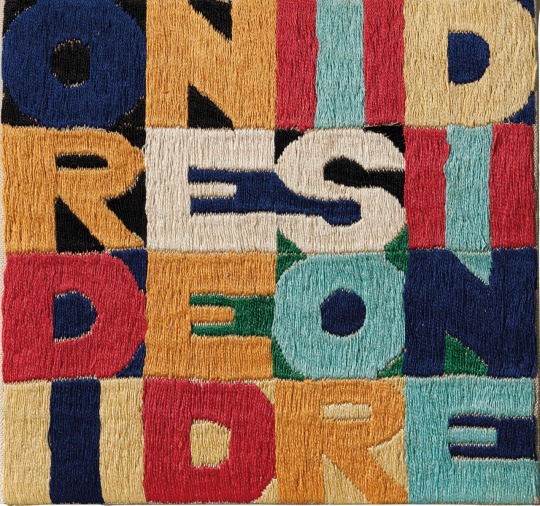





ALIGHIERO BOETTI'S TEXT/ILES
Alighiero Boetti was born in Torino in 1940. He studied business administration and mathematics before becoming an artist. Although he has been routinely associated with the Arte Povera movement of the 1960s, based largely on his choice of materials and general disdain for slick, industrial design, his art is more properly understood as Conceptual.
In 1972 he and his business partner, Gholam Dagastir, founded an artists' commune in Kabul called One Hotel. There Boetti met with teams of Afghan weavers and embroiderers who executed his series of textile maps of the world. The Soviet invasion of Afghanistan in 1979 forced this production to move to Pakistan. The Arazzi series-- square woven grids of 16- and 25-word Italian phrases--were executed in Peshawar in the 1980s and early '90s. The Arazzi reify the meaning of the Latin verb textere, or "to weave." The cryptic phrases ("Ordine in disordine," "Dare il tempo al tempo," "Niente da vedere, niente da nascondere,) which recall mottos, koans, aphorisms and proverbs, often refer (or at least can be applied) to aspects of Boetti's quirky aesthetic.
36 notes
·
View notes

